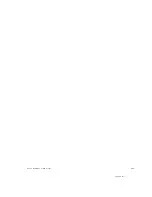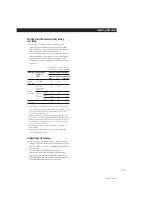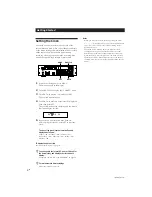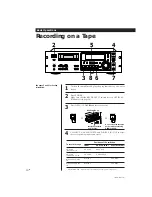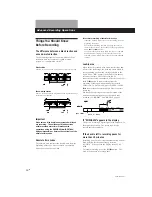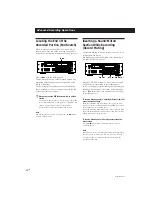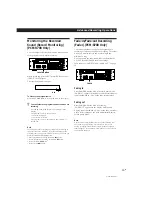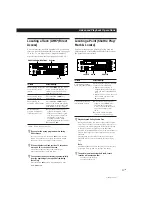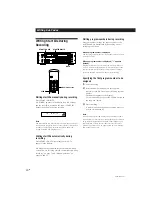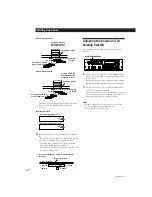
Getting Started
7
EN
3-
859
-278-12(1)
Writing start IDs automatically during
recording
•
When ”AUTO“ appears in the display during
recording, the automatic writing of start IDs takes
place according to the input connector used and the
signal format, as shown in the table below.
•
The condition for the automatic writing of start IDs
differs according to the category code in the digital
signal, such as an audio input level signal, a DAT
start ID code, or a Q-code from a CD track (see pages
24 and 25 ).
®
: automatic writing possible
×
: automatic writing prohibited
Automatic writing according to
Input signal
Q-code from
a CD track
DAT start
ID
b)
®
®
c)
×
®
®
d)
×
®
®
×
®
×
®
e)
®
×
×
®
×
×
Signal format
(Category
code)
DIGITAL
AES/EBU
AES/EBU
audio input
level
a)
IEC-958
for
consumer
use
IEC-958 for
broadcasting
studio use
(DAT)
(CD)
(Other)
ANALOG
DIGITAL
COAXIAL
—
a) If the input level remains under the level set in the ”L-SY
TH” menu longer than the time set in the ”L-SY BK” menu
(see page 24), the deck writes a start ID when the input
level rises above that level.
b) DAT skip IDs are automatically written in the same way.
c) Only when connected to the PCM-2600, PCM-2800, PCM-
R500 or PCM-R700. When the connected decks consist of
a PCM-R500 or PCM-R700, select “on” in the “AES S-ID”
menu of the playback deck.
d) Only when connected to the PCM-2300, PCM-2700, or
PCM-2700A.
e) Some CD players do not output track information (Q-
code) in the digital signal.
Digital signal lock range
•
The lock range of a digital signal (signal reception
range) is about
±
0.1% for a sampling frequency of 48
kHz, 44.1 kHz, or 32 kHz. Variable pitch signals are
not receivable.
•
When the digital input sampling frequency
information does not match the actual sampling
frequency, it is possible to record that signal if you
change the REC MODE switch on the front panel to
the actual sampling frequency of the signal.


